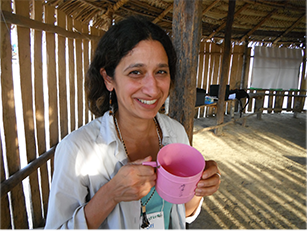As part of the work of Leverhulme Wildfires, we have developed new datasets which are publicly available, including on anthropogenic fire impacts, palaeofire and global fire use – you can read more about these and access the datasets below. Please get in touch if you would like to discuss the datasets, including new approaches to analysis. We also use and have expertise in many other open access databases as part of our research in the Centre. Some of these key databases are also listed below.
Leverhulme Wildfires Datasets
Fire Use
Global Fire Use Survey
Citation: Smith, Cathy; Mistry, Jay; Perkins, Oliver (2024). Global Fire Use Survey. Royal Holloway, University of London. Collection. https://doi.org/10.17637/rh.c.7082464.v1
Download/access: https://doi.org/10.17637/rh.c.7082464.v1
Description: The Global Fire Use Survey aimed to explore human fire use around the world. The survey was completed online by experts (including policymakers, researchers, and fire managers) worldwide. Respondents answered for specific pre-determined regions, which were delineated by country boundaries and ecoregions. The survey had four blocks of questions. The first focused on the stakeholder groups using fire, reasons for burning, and months in which specific fire uses occur. The second block focused on the human fire regime, including fire use by all stakeholders. This included questions about seasonal variation in burned area, fire ignitions, and risk of escaped fire, and about trends in burned area and ignitions since 1990. The third focused on fire governance, with questions about the amount of fire suppression by agencies, policy interventions affecting fire use, and the effectiveness of these. The fourth looked at the respondents’ expertise, including their professional background, research methods (if applicable), and specific years and locations for which their knowledge was deepest.
Published: 2024
LIFE: Database of subsistence-oriented and smallholder fire use and mitigation
Citation: Smith, Cathy; Mistry, Jay (2021). LIFE: Database of subsistence-oriented and smallholder fire use and mitigation. Royal Holloway, University of London. Collection. https://doi.org/10.17637/rh.c.5469993
Download/access: https://doi.org/10.17637/rh.c.5469993
Description: A global database of contemporary subsistence-oriented and smallholder fire use and mitigation practices in 587 case study locations described in the literature from published and unpublished sources. The database describes 1,708 contemporary subsistence-oriented and smallholder fire use and mitigation practices and contains data on both social and biophysical aspects of fire practices.
Publication: 2021
Related publications:
Smith, C., Perkins, O. & Mistry, J. Global decline in subsistence-oriented and smallholder fire use. Nat Sustain 5, 542–551 (2022). https://doi.org/10.1038/s41893-022-00867-y
Anthropogenic fire impacts
DAFI: a global database of Anthropogenic Fire
Citation: Perkins, Oliver; Millington, James (2021). DAFI: a global database of Anthropogenic Fire. figshare. Collection. https://doi.org/10.6084/m9.figshare.c.5290792.v4
Download/access: https://doi.org/10.6084/m9.figshare.c.5290792.v4
Description: The database of anthropogenic fire impacts (DAFI) is the product of a meta-analysis of more than 500 academic papers, government and NGO reports. It contains quantitative data on burned area, fire return interval and fire size as well as mixed qualitative-quantitative data on fire suppression and policy. Importantly, DAFI places human impacts on fire regimes within their underlying land use context, which supports understanding of how different socioeconomic systems have different attitudes and approaches towards fire use and management. Analysis of DAFI has identified 7 central modes of human fire use that capture 93% of records in the data set. DAFI has subsequently been used to parameterise the Wildfire Human Agency Model – a global behavioural model of human fire use and management.
Published: 2022
Palaeofire
The Reading Palaeofire Database v1b: an expanded global resource to document changes in fire regimes from sedimentary charcoal records
Download/access: https://doi.org/10.17864/1947.000345
Citation: Harrison, Sandy, Villegas-Diaz, Roberto, Lincoln, Paul, Kesner, David, Cruz-Silva, Esmeralda, Sweeney, Luke, Shen, Yicheng and Gallagher, Daniel (2022): The Reading Palaeofire Database v1b: an expanded global resource to document changes in fire regimes from sedimentary charcoal records. University of Reading. Dataset. https://doi.org/10.17864/1947.000345
Description: Wildfires have major impacts on terrestrial ecosystems, the global carbon cycle, atmospheric chemistry and climate. Charcoal records from sedimentary sequences provide a way to reconstruct palaeofire regimes at different temporal and spatial scales and are a key resource to improve our understanding of the drivers of wildfires. The RPD is an updated and expanded database of global charcoal records, accompanied by new Bayesian age models. This is an updated version of the RPD (RPDv1b), with updates to site, entity, sample and date_info metadata and the inclusion/updating of age models for 233 entities. The database contains 1676 charcoal records from 1480 sites worldwide. Age models have been run for 829 of the charcoal records.
Published: 2022
Related publications:
Harrison, S. P., Villegas-Diaz, R., Cruz-Silva, E., et al 2022.: The Reading Palaeofire Database: an expanded global resource to document changes in fire regimes from sedimentary charcoal records, Earth Syst. Sci. Data, 14, 1109–1124, https://doi.org/10.5194/essd-14-1109-2022
Open Access Datasets
Open access datasets which we use in our research will be listed here soon. Thank you for your patience whilst this page is in development.
- Vegetation Index: longterm_VI (snu.ac.kr)
Jeong, S., Ryu, Y., Gentine, P., Lian, X., Fang, J., Li, X., Dechant, B., Kong, J., Choi, W., Jiang, C., Keenan, T. F., Harrison, S. P., & Prentice, I. C. (2024). Persistent global greening over the last four decades using novel long-term vegetation index data with enhanced temporal consistency. Remote Sensing of Environment, 311, 114282. [HTML] (2024.09)











